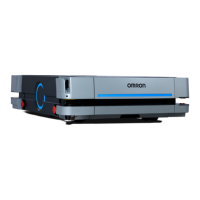131 HD-1500 Platform User's Manual 31500-000 Rev A
4.2 Create a Workspace Map
Map Description
Before you can use your HD-1500, you must create a digitized map of its designated work-
space. The map records the shape and location of permanent physical features in the work-
space. These features are walls, corners, doors, columns and large immovable fixtures such as
machines or fixed industrial shelving.
Moving objects (such as fork-lift trucks and carts) or transient objects (such as pallets loaded
with finished goods) do not provide useful mapping data. Erase such objects from the map
after you create it.
Map Laser Scan
The HD-1500's Safety Scanning Lasers scan the workspace to create the map. The lasers scan
only a narrow horizontal plane, parallel to the floor. The scanning plane height is 175 mm
above the floor, so the lasers cannot detect physical features above or below this plane, or fea-
tures that are out of operating range and resolution. This means that some features are not
recorded on the map such as:
l Overhanging objects, such as:
o
Shelves that are attached to a wall, but at a low height so that there is clear space
underneath.
o
Tables with narrow supporting legs.
l
Low-lying objects that are below the scanning plain such as a column plinth or a pallet
that contains no cargo.
Map Creation and Editing
You use the MobilePlanner software to create and then edit your workspace map. You can add
virtual elements to the map that modify the behavior of an AMR. Examples of virtual ele-
ments include:
l
Forbidden lines and areas—Areas in the workspace where an AMR cannot enter or
move across.
l
Movement parameters sectors—Areas where an AMR must travel within a specified
speed range.
l
Preferred lines—Paths that you specify on the map which the AMR must consider
when planning the most efficient path to follow autonomously to its goal.
l
Preferred-direction zones—Areas where the AMR will prefer to travel in a specified dir-
ection. In a typical preferred direction zone (such as a narrow hallway) there is an
opposite direction that you want the AMR to avoid. Use a preferred-direction zone to
keep the AMRto the preferred side of a hallway. The AMRis able to travel on the altern-
ate side of the zone if the preferred side is blocked.
Regardless of the constraint specified by any virtual element on the map, the AMR always
operates according to its safety protocols. For example, when following a preferred line the
AMR still responds to, and avoids, dynamic obstacles.
Maps contain a variety of goals, routes, and tasks that comprise the destinations and activities
of the AMR in the workspace. Refer to the Fleet Operations Workspace Core User's Manual (Cat.
No. I635) for information about editing a map.

